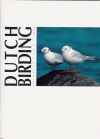Dutch Birding volume 25 (2003) no 2

'Black-eared wheatear' at Aagtekerke, the Netherlands, in June 1996
An immature male 'black-eared wheatear' at Aagtekerke, Zeeland, the Netherlands, on 2-4 June 1996 was identified and accepted as a Western Black-eared Wheatear Oenanthe hispanica (hereafter hispanica) (eg, Klootwijk & Kuijpers 1996, van den Berg & Bosman 1999, 2001; Dutch Birding 18, 154, plate 168, 1996, 20: 157, plate 120, 1998).
However, first-summer males hispanica generally resemble adult males with a uniform and often rather warm ochre crown, nape and mantle as well as jet-black coverts. This is inconsistent with the Aagtekerke bird which shows an obvious contrast between the greyish, 'dirty' crown and nape and rather ochre mantle as well as brownish-black greater coverts indicative of immature male Eastern Black-eared Wheatear O melanoleuca (hereafter melanoleuca). Moreover, the throat-bib to some extent covers the upper breast, again inconsistent with hispanica. While many melanoleuca males undeniably show a larger throat-bib than the Aagtekerke bird, the blackish 'stains' below the rear end of the ear-coverts suggest that 'there is more to come' - this bird will probably have a larger throat-bib when it becomes adult. The fact that the breast is thoroughly warm ochre all the way up to the throat-bib also indicates melanoleuca, while typical hispanica has a narrow pale, off-white zone between the throat-bib's black and the breast's ochre (cf Ullman 2003).
The amount of black above the eye and across the forehead may seem too restricted for melanoleuca, but immature males melanoleuca regularly have less black on these parts than adult males. And anyway, the black on the lores reaches too high for hispanica, and indicates that the bird is a melanoleuca.
Thus, I suggest that the Aagtekerke wheatear is, in fact, an Eastern Black-eared Wheatear.
Editorial note: On basis of Magnus Ullman's arguments described in this letter, the record has been resubmitted to the Dutch rarities committee (CDNA); the CDNA has decided that the record should be reviewed as Eastern Black-eared Wheatear. In addition, all accepted records of black-eared wheatear on the Dutch list (four hispanica and two melanoleuca) will be reviewed, together with a pending record of a presumed hispanica from 2001 (cf van der Vliet et al 2002) (Nils van Duivendijk in litt). EDITORS
Magnus Ullman, Iliongr K:104, SE-224 71 Lund, Sweden
ullman.apus djingis.se
djingis.se
terug






